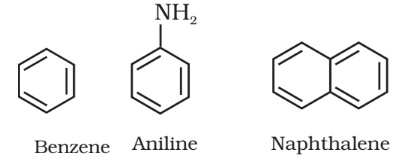Aromatic compounds are an outsized category of unsaturated chemical compounds characterised by one or additional planar rings of atoms joined by valence bonds of two completely different sorts. The distinctive stability of those compounds is brought up as aromaticity. The phrase was previously used in the case of odour, but nowadays its use in the field of chemistry is restricted to compounds that have clear electronic, structural, or chemical properties.
Substitution reactions on aromatic compounds are the most vital procedure for the production of aromatic compounds. Manufacturing them from non-aromatic precursors is significantly less. Through this reaction, the electrophiles and nucleophiles are often found in aromatics. There are many mechanisms for this.
Aromatic Compounds
Aromaticity, a core concept in chemistry, was introduced to account for the bonding, stability, reactivity, and alternative properties of the many unsaturated organic compounds. Aromatic compounds are the compounds that contain sigma bonds and delocalised pi electrons in a ring .Example :

Due to their pleasant odor ,they are termed aromatic. For compounds to be considered aromatic compounds,they need to follow Huckel rule( i.e., Aromatic ring should be planar ,have complete delocalization of pi electrons in the ring and presence of (4n +2)ℿ electrons in the ring where n =0,1,2…). Substitution is additionally favourable because it permits the aromatic structure to stay. The aromatic structure provides vital extra stability to the molecule. Substitution reactions enable the aromatic structure to stay, whereas additions would modify the C-C bonding far from being aromatic. This is unfavourable.
Substituted Aromatic Compounds
Substitution reactions on aromatic compounds are the primary important plan for the preparation of aromatic compounds. The compounds support substitution reactions, during which the hydrogen is replaced with an electrophile. Thus their reactions begin through electrophilic substitution. Examples of substituted aromatic compounds are as follows:
Aromatic compounds have double bonds similar to alkenes. However, they do not bear an electrophilic addition. A result of this would lead to their loss of ring aromaticity. The sequence of the substitution on compounds is controlled by the character of substituents that are in the ring.
In electrophilic aromatic substitution reactions, a positively charged carbon ion is formed, whereas in the nucleophilic aromatic substitutions, a negatively charged carbon ion is formed.
Hydrogenation Reactions Convert Aromatic Compounds to Saturated Compounds
Metal cross-coupling, like the Suzuki reaction, permits the formation of carbon-carbon bonds between two or many aromatic compounds.
Nucleophilic substitution reaction
A nucleophilic substitution reaction is a type of chemical reaction in which the full electron nucleophile charges on the positive charge electrophile to substitute a leaving group. It is a negative charge (or without charge) with a couple of donable electrons. It requires heavy electrons to react with the electrophile.
Where R is alkyl or aryl group, X is leaving group such as halogen etc. and Nu- is nucleophile( example hydroxide ions)
Since water can be a nucleophile, a liquid solvent system results in the unwanted reaction of water with the reactive electrophile. Moreover, the electrophilic molecule might not essentially be miscible in water. Nucleophilic substitution reactions will make the most of the flexibility to dissolve alginates in organic media.
Electrophilic Substitution Aromatic Compound
In this type of reaction, a substituent on an aromatic ring is replaced by an electrophile.
The first step of reaction starts with the electrophile attacking the pi-electron present in the aromatic benzene ring. It leads to the development of charged and delocalised cyclohexadienyl ions.
These ions are the arenium ions. This particle primarily has three resonance contributors. The electrophile attacks the aromatic ring.
This process is a very time taking and slow method. Due to the loss of aromaticity, there is a high energy activator there, and this reaction is endergonic.
Some of the critical factors that affect the electrophile reaction here are steric hindrance and chance.
The second step demands the removal of protons and fills with electrons of the arenium ion by a weak base.
A base attacks the positively charged carbon atom, leading to the loss of a proton. The electrons then want to reform a pi bond, and aromaticity is repaired.
This reaction is a quick method and typically exergonic. Remember that the positively charged carbon atom loses a proton here as an electrophile is charging the benzene ring.
Multiple patterns are determined relating to the reaction of substituted aromatic hydrocarbon rings. These are generalised to produce a prognostic rule for electrophilic aromatic substitutions (EAS). A negative charge particle giving substituent usually speeds up the substitution and directs reactivity toward the positions that are ortho and para to that on the ring, whereas a negative charged particle withdrawing substituent can slow reaction progress and benefit the meta position on the ring.
EAS happens ortho or para to electron donating groups, like amines, due to the stabilisation of the intermediate charge. Because of the electrons provided by the NH2 cluster, this intermediate is stable, and the para-substitution is favoured. To observe this, prolong the stabilisation of the charge once ortho substitution happens.
Conclusion
Substitution reactions in an aromatic compound are important to form an aromatic compound. The resonance of the aromatic compound makes the compound stable and does not prefer an additional reaction. It is of two types, and both types of reactions are mostly used to form a new element in the field of organic chemistry.
 Profile
Profile Settings
Settings Refer your friends
Refer your friends Sign out
Sign out






